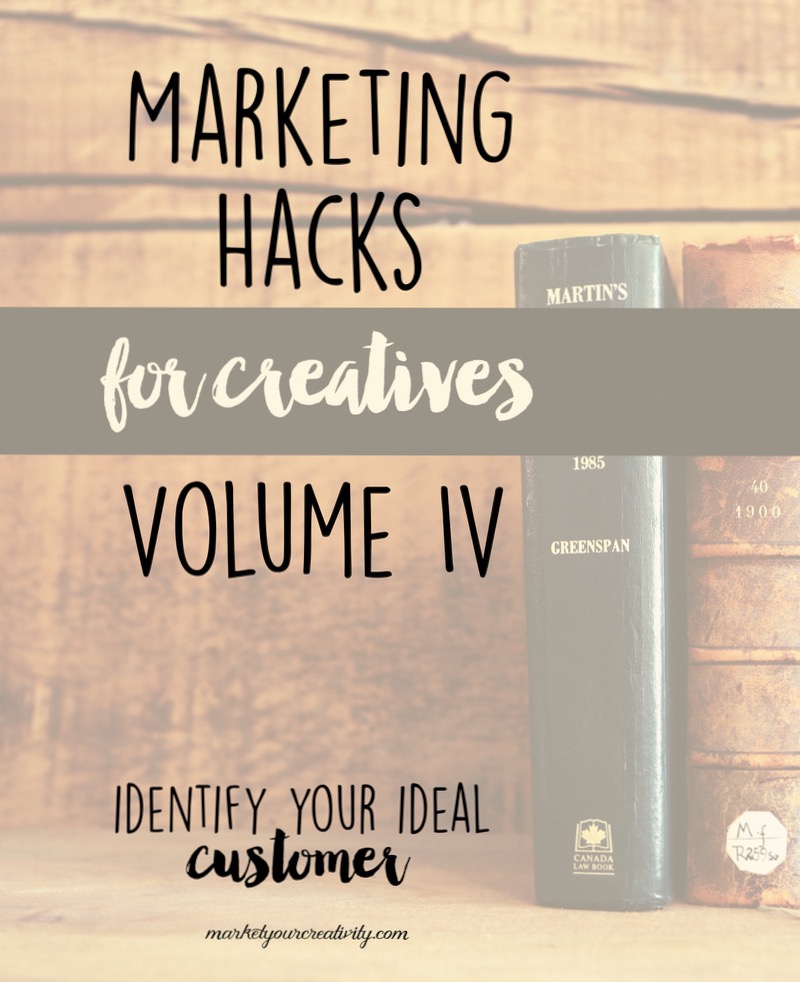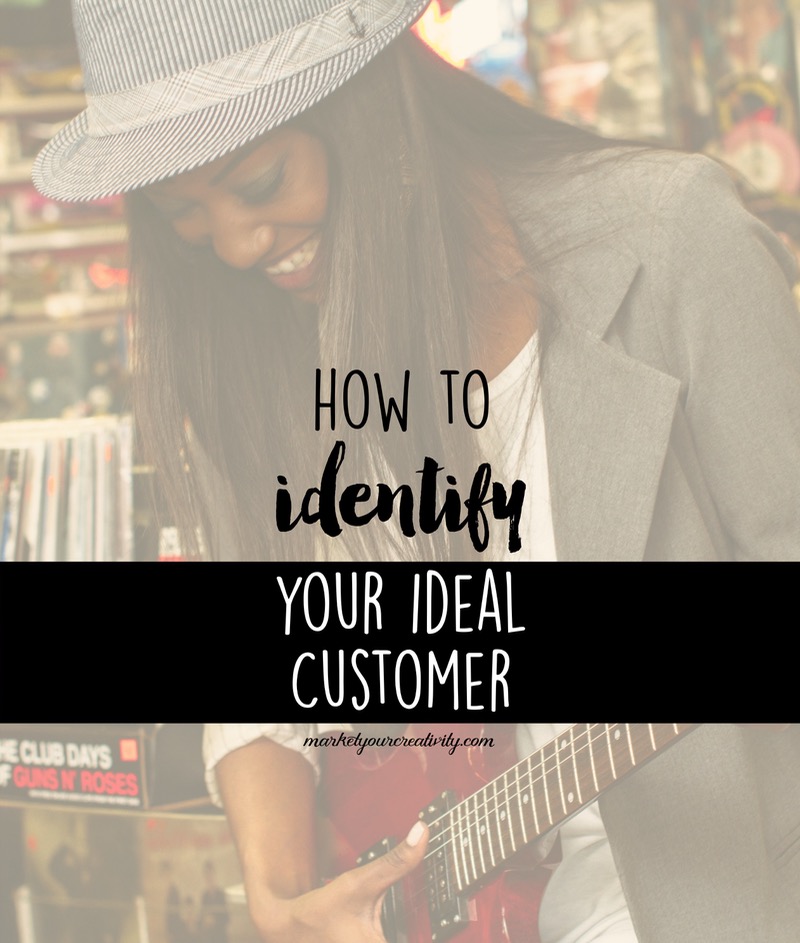Alright, the next few volumes of Marketing Hacks for Creatives are going to be insanely useful for your business, but there’s one thing you must do first: The Ideal Customer Exercise.
If you’re at a place in business where you feel as though you’re all in – you’re putting in the time, energy and production it takes to build a selling storefront – but the business isn’t giving back (in the form of sales, growth and revenue), then this ideal customer exercise is going to be your first step in getting on the right track.
Are you …
- doing a lot of talking and posting, but feel as though nobody is listening?
- churning out a lot of products, but nobody’s buying?
- reaching for customers every way you know how, but connecting with no one?
If so, the ideal customer exercise is for you. Welcome to an ongoing series on Marketing Creativity: Marketing Hacks for Creatives (coming to you in volumes), building off the post, The Ultimate Guide to Marketing for Creatives. In case you’re just joining me, it’s best to start there for a complete picture of all that we’re going to cover.
The general advice for marketing in business is to “write as if you’re talking to one person.” Right? I’ve heard that floating around, and I’m sure you have, too.
The problem with that advice is that it’s incredibly generic.
Imagine I issued you a coaching assignment in which you had to go out all day long and have sales conversations with everyone you encounter. You have to go shopping, grab a coffee, have lunch with an old friend, etc., but you have to be out all day and put yourself in front of a mix of new people.
If you’re anything like me, this wouldn’t be a comfortable assignment (I’m an introvert through and through), but it would be doable. I would think ahead on every situation and consider HOW I would approach them. At check-out, I might notice a store clerk’s jewelry, then offer her a free sample with my business card. I could cut straight to the point with an old friend. Approaching all of these people might not be comfortable for me, but I would work it out.
But what if I layered on that generic advice and told you that you had to speak “as if you’re talking to one person”, and you had to have the same exact sales conversation with everyone you encountered? I don’t know about you, but I’d quit the coaching assignment based on how that would make people feel.
You see, if you’re not addressing your customers in a very personal and targeted manner, you make everyone you encounter feel like prospects. And that’s never how I want people who hire or buy from me to feel.
Today we’re going to talk about WHO you’re approaching, and in upcoming volumes, I’ll show you exactly HOW to approach your ideal customer in a personal way that leaves them feeling cared for, heard and understood. (By the way, if you’re nodding your head and thinking, “YES, PLEASE!” to that lesson, check out my Copywriting for Crafters class on CreativeLive. You will absolutely devour the lesson!)
We need your art
As makers and artists, you offer a unique value: you provide your customers with that special feeling only an item made from creative passion can produce. Artists and crafters love what they do so much that they often cringe at the idea of targeted marketing. In fact, the notion of cold-selling what’s been made with a warm heart makes many creatives downright uncomfortable.
However, targeted marketing (and performing this ideal customer exercise) simply means finding the customers who desire your work. It’s introducing yourself to people who think you’re a Pablo Picasso, rather than waiting a lifetime and beyond hoping that they’ll stumble across your most talented piece. It’s time to show the world what you’ve got to offer and find more paying customers for your creative business because …
It’s time to replace the cringe of old-fashioned marketing with the warm and inviting smile of today’s socially-acceptable advertising. Messages no longer blare, flash, or otherwise interrupt your life … unless you give them permission to do so. In fact, permission marketing (where customers sign up, request more, and voluntarily follow what you’re doing) is what’s happening in the advertising world today.
And there’s nothing cringe-worthy about giving customers what they’re asking for. In fact, it’s the very best way to make your customer feel heard and understood. They came to you because you have something they want to buy. Selling them exactly what they need serves them in the best way imaginable; it benefits you both.
You have something valuable for sale. The question becomes: How do I find the people who value it? And we don’t want just anybody’s attention. When you say your product is for “everybody”, you might as well say it’s for nobody because nothing’s for everyone. Instead, it’s for a select sea of people who share your taste, have an eye for your talents, and love the quality product you produce.
The one thing you MUST DO before attempting any type of marketing is …
Identify Your Ideal Customer
This is a personal exercise for your business, and one you should take very seriously. I instruct my clients to sit down with pen and paper, and really take the time to focus on this assignment.
The ideal customer has many different names in marketing and business. It’s also referred to as the “customer profile”, “customer avatar”, I call mine “dream clients”, etc. But, it all means the same thing. The ideal customer is a fictional description of a single person, and that one person represents your entire customer base. The ideal customer is the sum total of similar traits, hobbies and interests that your entire customer base might have in common.
The ideal customer is a fictional profile, and while this person does not actually exist, it can be based on actual customers you’ve had (or you want). I’m so proud of my clients, and they make me smile for different reasons all of the time. I continuously ask myself: “What attribute, characteristic or attitude am I loving about this person?” And then, I add that trait to my ideal customer profile because I want to attract MORE of it in business.
The ideal customer exercise never excludes other shoppers. I hear this concern a lot, like so, “If I’m writing and marketing to a specific person, say a middle-aged women decorating her home, then men or professional interior designers won’t buy.” Wrong! In fact, that couldn’t be further from the truth.
This exercise does not exclude any customers, but it DOES make a specific customer feel a deep sense of belonging. When you create that sense of belonging with your ideal customer, everyone feels it. It builds more feelings of belonging and attracts loyalty to your brand.
I’m going to get you started with a few prompts right here, but if you really want to take this exercise to the next level (and I highly recommend that you do), I’m giving away a more in-depth workbook to get you there at the end of this post. In order to find your ideal customer, you have to identify them first. This is going to be the ultimate fan of your work …
- Is your ideal customer a male or female? (I’m going to refer to her as a she)
- How old is she?
- Is she single or married?
- Does she have children or not?
- Does she exercise, and if so, what’s her preferred method?
- Is she city or country?
- Conventional or quirky?
- Does she like to stand out from the crowd or not?
- From which genre does she buy most of her books?
- Which magazines does she subscribe to?
- What television shows does she watch?
- Where does she love to go for vacation?
There are as many things to know about your ideal customer as there are to know about your best friend or spouse. The more you understand this person, the better you’ll be able to connect and market to them in a way that makes them feel heard and understood. In the next volumes of this series, I’m going to show the many valuable ways you can use this information for your business.
Once you have an ideal customer profile, you want your business to reach the people in that customer base all the time. Like in the coaching assignment I mentioned earlier, some of them will be strangers and some of them will have been with your brand so long that they feel like old friends.
So, HOW do you talk to all of those people, in all of those different stages, in a way that shows genuine interest? That’s what we’ll be talking about in the next volumes of Marketing Hacks for Creatives! Be sure to stay tuned.
Until next time and all the best,






This is great, and just in time for me too! I’m dedicating this month to really identifying who my dream clients are and how I can communicate with them. I signed up and can’t wait to read more!
Excellent, Nessa! It’s an important area of focus for sure. Best of luck with the assignment!
Thanks, Lisa. I’ve been having a heck of a time trying to determine my ideal customer. I’m sure your insight will help me quite a bit. Thanks again! Sharon
Great, Sharon – I’m glad it’s coming to you at a good time! Good luck.
Very happy you are writing about this topic, Lisa. As someone who just started and has 1 customer (a very ideal one I have to say) and my mum OK, this is something I am really struggling with. Every time I try to do this exercise I end up at the same point, my ideal customer looks exactly like….. me! I don’t think this is a good thing?
Anyway… this is great help and I can’t wait to read your next blog post too. Thank you for all the goodies!!
Yes – I think a lot of times your ideal customer starts out looking very much like you. After all, your product is going to appeal to you! So this fictional character is sure to have similar traits.
Best of luck!
Love this! “When you create that sense of belonging with your ideal customer, everyone feels it. It builds more feelings of belonging and attracts loyalty to your brand.” Tweeting…
Thank you, Katie + fun fact – you can now highlight ANY text on my site and it becomes a tweet! I’m loving it! Appreciate the share <3